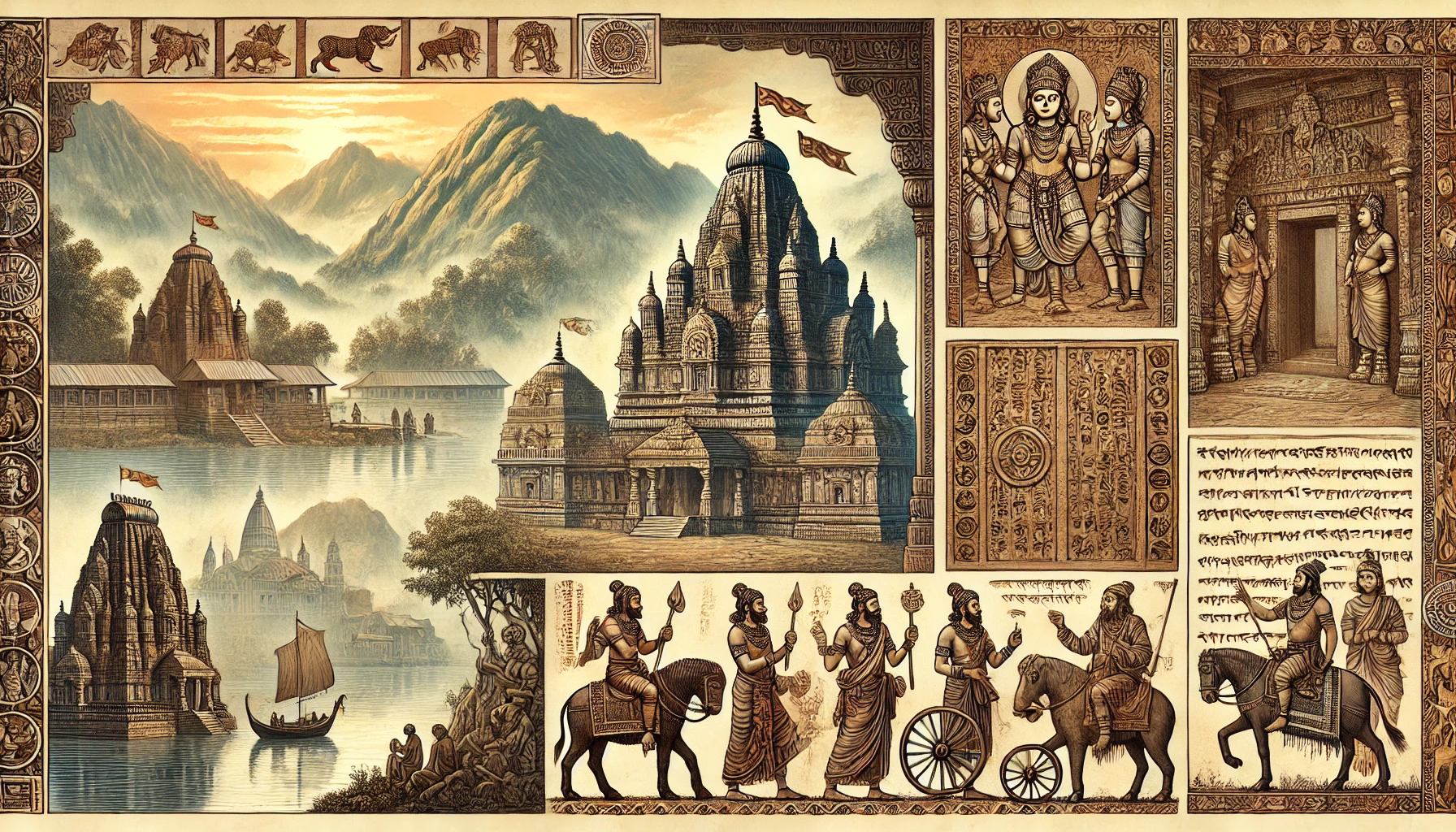Assam, a land known for its lush landscapes, tea gardens, and vibrant culture, holds a deep and fascinating history that stretches back thousands of years. Nestled in the northeastern part of India, Assam’s story is one of rich cultural evolution, diverse dynasties, and ancient civilizations. As we delve into the early history of Assam, we uncover the various phases of its formation, the significance of its ancient names, and the legacy of its earliest historical dynasties. This exploration provides a comprehensive look at how Assam's identity was shaped, laying the foundation for its current cultural and social fabric.
Ancient Beginnings – The Formation of Assam
The history of Assam is deeply intertwined with the geography of the region. The fertile Brahmaputra Valley provided a cradle for ancient settlements and nurtured one of the earliest known civilizations in this part of the Indian subcontinent. While the exact origins of Assam remain somewhat elusive, archaeological evidence suggests that organized human settlements in the region date back to the early Stone Age. These early communities, drawn by the abundant natural resources, established the first villages that would later evolve into thriving centers of civilization.
The formation of Assam as a recognized entity is believed to have started with small kingdoms and tribal settlements that developed independently before merging into more structured dynastic systems. The land was not only favored by its geographical features but also enriched by its connections to trade routes that linked it to Southeast Asia and beyond, bringing with it new ideas, customs, and religions.
The Ancient Names of Assam – Kamarupa and Beyond
Assam’s history is marked by the evolution of its name, with ancient names that reflect its changing cultural and political landscape. One of the earliest known names for Assam was Kamarupa, a term that appears in a variety of ancient texts and inscriptions. This name, steeped in mythology, is derived from Sanskrit, translating to “the form of desire.” According to legend, this land was blessed by the Hindu god Kamadeva, the god of love, whose influence bestowed the name Kamarupa.
Before it was known as Kamarupa, however, Assam’s oldest name remains somewhat debated, with some historical texts referring to the area as Pragjyotisha. Pragjyotisha is often associated with astrology and celestial sciences, suggesting that this land was once a center for learning and knowledge. This ancient identity is preserved in various Hindu epics, including the Mahabharata, where the kingdom of Pragjyotisha plays a key role, symbolizing Assam's integration into the broader tapestry of Indian civilization.
The old name of Assam, Kamarupa, became well-established during the early centuries of the Common Era, representing a powerful kingdom that would continue to evolve over the centuries.
The Rise of the Kamarupa Dynasty – Assam’s Earliest Historical Dynasty
The Kamarupa dynasty is one of the earliest and most significant dynasties in Assam’s ancient history. Established around the 4th century CE, this dynasty laid the groundwork for Assam’s political and cultural identity. Under the Kamarupa kingdom, Assam experienced a period of remarkable growth in art, culture, and architecture. Kamarupa rulers were known for their support of the arts and education, commissioning temples and other architectural marvels that reinforced Hinduism’s influence in the region.
The Kamarupa kingdom was ruled by three major dynastic lineages: the Varmans, the Mlechchhas, and the Palas. Each of these lineages left a unique mark on Assam’s history:
- The Varmans (350–650 CE): The Varman dynasty is credited with establishing the first strong centralized rule in Assam. Their reign witnessed significant political consolidation and expansion of territory.
- The Mlechchhas (650–900 CE): Following the Varmans, the Mlechchha rulers maintained the stability of the kingdom and continued to promote Hinduism.
- The Palas (900–1100 CE): The Pala dynasty took over from the Mlechchhas and saw further consolidation of Assam's territory. They fostered a period of cultural and architectural achievement, with several temples constructed during their rule.
This period of rule by the Kamarupa dynasty marks an important chapter in the earliest historical dynasty of Assam, as it represents the first major consolidation of power in the region.
The Cultural Landscape of Ancient Assam
The early history of Assam is not solely defined by its political evolution but is equally enriched by its cultural heritage. The region was a melting pot of various ethnic groups and cultures, leading to a diverse social fabric that still influences Assamese culture today. The blending of indigenous traditions with those brought by various migratory groups resulted in a unique cultural identity.
Religious Influences
Religion played a crucial role in shaping ancient Assamese society. The Kamarupa dynasty was marked by the influence of both Hinduism and Buddhism. Temples dedicated to deities like Shiva and Durga were constructed, showcasing intricate architecture and artistry that reflected the religious devotion of the time. The famous Kamakhya Temple, one of the oldest Shakti temples, is a testament to the deep-rooted religious traditions of the region.
Buddhism also flourished in ancient Assam, particularly under the patronage of the Palas. Numerous stupas and monasteries were built, facilitating the spread of Buddhist teachings and philosophies across the region. The coexistence of Hinduism and Buddhism contributed to a rich tapestry of rituals, festivals, and art forms that characterized ancient Assamese culture.
Linguistic Development
The linguistic landscape of ancient Assam was equally diverse, with various languages and dialects spoken by its inhabitants. The influence of Sanskrit is evident in many of the ancient texts, inscriptions, and literary works produced during this period. Assamese, which evolved from these roots, became a prominent language, serving as a medium for cultural expression and communication.
The Influence of Trade and Migration in Assam
Trade played a pivotal role in the historical development of Assam. The region's strategic location along ancient trade routes facilitated commerce with neighboring regions, including Tibet, China, and Southeast Asia. This not only contributed to the economic prosperity of Assam but also fostered cultural exchanges that enriched its history.
Trade Routes and Economic Prosperity
The Brahmaputra River served as a vital trade artery, enabling the movement of goods and people. Merchants from various cultures converged in Assam, bringing with them goods such as silk, spices, and handicrafts. This trade not only stimulated the local economy but also introduced new ideas and practices, further diversifying the cultural landscape.
Migration Patterns
Assam's early history also witnessed significant migration patterns. Various ethnic groups, including the Ahoms, Kacharis, and Nagas, migrated to the region over the centuries, each contributing to the socio-cultural milieu. The Ahoms, in particular, arrived in the 13th century and established a powerful dynasty that would shape Assam's history for centuries to come. Their unique administrative practices, military strategies, and cultural influences left an indelible mark on Assam's development.
Assam in the Medieval Period – The Ahom Dynasty
The arrival of the Ahoms in the 13th century marks a significant turning point in the history of Assam. They established a dynasty that would last for nearly 600 years, transforming the region's political landscape and cultural identity.
The Rise of the Ahoms
The Ahoms were originally a Tai-speaking people from Southeast Asia who migrated to Assam. Under the leadership of Sukapha, they successfully established the Ahom kingdom, which became a formidable force in the region. The Ahom dynasty introduced innovative administrative practices, military strategies, and cultural elements that significantly influenced Assamese society.
Cultural Contributions
The Ahom period is noted for its contributions to art, literature, and architecture. The construction of monumental structures such as Sivadol and Talatal Ghar exemplifies the architectural prowess of the Ahoms. The dynasty also witnessed the flourishing of Assamese literature, with notable figures like the poet Bhagavat contributing to the literary heritage of the region.
The Battle Against Mughal Expansion
One of the defining moments in Assam's medieval history was the successful resistance against Mughal invasions in the late 17th century. The Ahoms showcased their military prowess in battles such as the Battle of Saraighat in 1671, where they successfully defended their territory against the Mughal Empire, solidifying their reputation as a powerful kingdom in northeastern India.
Socio-Political Structure of Ancient Assam
The socio-political structure of ancient Assam was characterized by a complex interplay of dynastic rule, tribal affiliations, and community governance. The region was home to various tribal communities, each with its own customs, traditions, and governance systems.
The Role of Chiefs and Local Governance
Local governance in ancient Assam often revolved around the authority of chiefs or village heads. These leaders played a crucial role in maintaining order and ensuring the welfare of their communities. The hierarchical structure allowed for the coexistence of various ethnic groups while preserving their distinct identities.
Caste System and Social Organization
The caste system also began to take shape during this period, influencing social dynamics. While the Kshatriyas (warriors) and Brahmins (priests) held prominent positions, other communities contributed to the agrarian and trade-based economy of Assam. The fluidity of the caste system in some regions allowed for inter-community interactions, fostering a sense of unity amidst diversity.
The Legacy of Ancient Assam
The early history of Assam is a tapestry woven from threads of ancient civilizations, cultural exchanges, and dynastic legacies. From the Kamarupa dynasty to the emergence of the Ahoms, the region has been shaped by its rich heritage and diverse influences. Understanding this history not only sheds light on the roots of Assamese identity but also highlights the resilience and adaptability of its people.
As we continue to explore Assam’s past, it becomes evident that the lessons learned from its ancient history continue to resonate today. The legacies of cultural richness, communal harmony, and a spirit of resistance serve as a foundation for a vibrant Assam that proudly carries forward its heritage into the future.
Learn With MCQs – Ancient History of Assam MCQs | Culture & Legacy





